Think eating “low-fat” foods is the key to healing fatty liver? Think again. Recent research published in The Lancet reveals a startling truth: many “diet foods” marketed for liver health may actually be making your fatty liver worse. The real surprise? Some foods traditionally considered “unhealthy” – like egg yolks and certain types of fat – have been shown in clinical studies to actively reduces liver fat.
A groundbreaking 2023 study in the Journal of Hepatology challenges everything we thought we knew about the best foods for fatty liver. While most people focus on avoiding fats, researchers discovered that specific food combinations can actually reverse fatty liver disease – regardless of their fat content. The key lies not in how much fat a food contains, but in how it affects your body’s metabolism.
Today at IFitCenter, we’ll explore these 14 science-backed foods that are transforming our understanding of liver health. You’ll discover why some “healthy” foods might be sabotaging your liver, and which surprising foods actually help heal fatty liver disease. More importantly, you’ll learn exactly how to combine these foods for maximum benefit, based on the latest medical research.
How Food Affects Fatty Liver Health
Think of your liver as your body’s processing plant. Just like a factory that sorts and processes different materials, your liver handles everything you eat. But here’s the fascinating part: different foods can either help clean up this factory or make it work overtime.
“Most patients are surprised to learn that it’s not just about avoiding fats – it’s about understanding metabolic timing. When you consume carbohydrates matters just as much as what you consume. Our liver’s ability to process nutrients varies throughout the day, which is why I often see better results in patients who time their meals properly rather than just restricting calories.”
Dr. Babak Jamalian, Family Physician.
The Metabolic Impact of Foods on Your Liver
When you eat, your liver immediately goes to work. But not all foods trigger the same response. For example, when you consume foods high in refined sugars, your liver responds much like a warehouse being overwhelmed with inventory – it has to quickly convert and store this excess as fat. This process, called de novo lipogenesis, is responsible for nearly 26% of all liver fat accumulation.
On the flip side, certain nutrients act like efficiency experts for your liver. Protein, for instance, helps repair and maintain liver cells, while specific types of fats can actually help reduce liver fat storage – a fact that surprises many people struggling with fatty liver disease.
Key Nutrients That Support Liver Function
Your liver requires specific nutrients to function optimally. Think of these as essential tools for liver repair and maintenance:
- Choline: Acts like a natural fat removal system, helping transport fat out of your liver
- Omega-3 fatty acids: Work as natural anti-inflammatory agents, reducing liver inflammation
- Fiber: Functions like a cleanup crew, helping remove toxins and supporting healthy bile production
The Power of Antioxidants and Anti-inflammatory Compounds
Antioxidants and anti-inflammatory compounds in food work like a protective shield for your liver cells. Recent research shows that these compounds can reduce liver enzyme levels in just three months. Some of the most powerful include polyphenols from green tea, resveratrol from grapes, and curcumin from turmeric.
“The relationship between dietary antioxidants and liver health represents one of the most promising areas in fatty liver disease management,” notes the Journal of Hepatology in their 2023 review of nutritional interventions for fatty liver disease.
On the IFitCenter blog, we have published a free content database about fatty liver disease that can have a significant impact for you in controlling and preventing this disease. For access, simply use the links below:
- what is a fatty liver and what causes it
- fatty liver causes
- fatty liver symptoms
- fatty liver types
- is fasting good for the liver
- how do you test for fatty liver disease
- Is canola oil healthy?
The Best Food Groups for Fatty Liver Recovery
When it comes to healing fatty liver disease, certain food groups stand out for their therapeutic properties. Let’s start with one of the most powerful: protein-rich foods in “foods good for fatty liver group” .
Important note: Physical condition and health status are highly important when using dietary products. This article is educational and based on conducted research. For full precaution, it is advisable to consult a specialist before starting any type of diet regimen.
Best Protein Foods for Fatty Liver Health
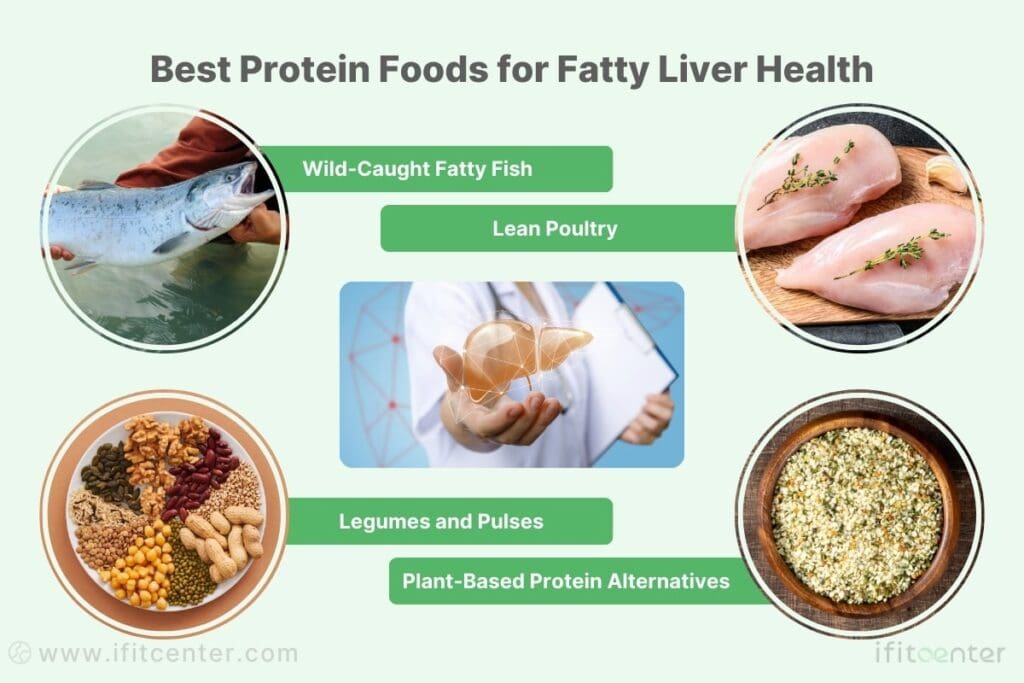
High-quality protein supports liver health by aiding in cell repair and reducing fat accumulation risks.
1. Wild-Caught Fatty Fish: Your Liver’s Best Friend
Wild-caught fatty fish tops the list of beneficial proteins for fatty liver recovery. Here’s why:
- Salmon: Rich in omega-3 fatty acids that reduce liver inflammation
- Sardines: High in protein and vitamin D, supporting liver cell repair
- Mackerel: Contains compounds that help prevent fat accumulation in the liver
Omega-3 fatty acids in wild-caught fatty fish, such as salmon and sardines, are known to reduce liver inflammation and support overall liver health.
2. Lean Poultry: Essential Protein Without Excess Fat
Lean poultry provides essential amino acids that support liver health without adding unnecessary saturated fats:
- Skinless chicken breast
- Turkey breast
- Duck breast (with skin removed)
3. Legumes and Pulses: Plant-Powered Liver Support
Legumes offer a powerful combination of protein and fiber, both crucial for liver health:
- Lentils: High in fiber and iron, supporting liver detoxification
- Chickpeas: Rich in choline, essential for fat metabolism
- Black beans: Contain antioxidants that protect liver cells
4. Plant-Based Protein Alternatives
For those following a plant-based diet, these alternatives provide excellent protein support:
- Tempeh: Fermented soy that’s easier to digest than other soy products
- Quinoa: A complete protein containing all essential amino acids
- Hemp seeds: Rich in both protein and beneficial omega fatty acids
Optimal Portions and Preparation Methods
For maximum liver health benefits, aim for:
- Fatty fish: 3-4 ounces, 2-3 times per week
- Lean poultry: 4-6 ounces per serving
- Legumes: 1/2 cup cooked serving daily
- Plant-based alternatives: According to package serving suggestions
Best preparation methods include:
- Grilling or baking fish with minimal added oils
- Steaming or roasting poultry to maintain moisture without excess fat
- Cooking legumes thoroughly to improve digestibility
- Using herbs and spices instead of salt for flavoring
“The type and quality of protein in your diet can significantly impact liver health and recovery from fatty liver disease.”
Best High-Fiber Foods for Fatty Liver Recovery
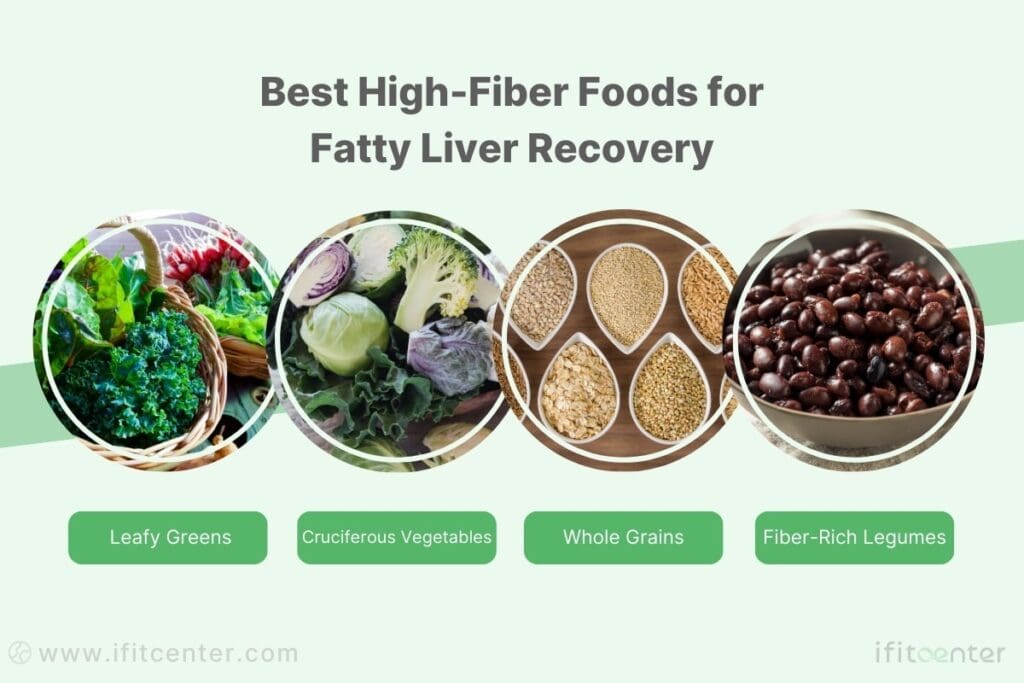
Fiber isn’t just about digestive health – it’s a powerful ally in fighting fatty liver disease. Recent research shows that increasing fiber intake can reduce liver fat. But not all fiber sources are equally effective.
1. Leafy Greens: Nature’s Liver Cleaners
Leafy greens contain specific compounds that actively support liver health:
- Arugula: Contains nitrates that improve blood flow to the liver
- Spinach: Rich in glutathione, the liver’s primary detoxification compound
- Swiss chard: Provides unique antioxidants that protect liver cells
Research published in the Journal of Hepatology shows that consuming leafy greens daily can improve liver enzyme levels..
2. Cruciferous Vegetables: Powerful Liver Support
These vegetables contain unique sulfur compounds that enhance liver function:
- Broccoli: Contains sulforaphane, which reduces liver inflammation
- Brussels sprouts: Support the liver’s natural detoxification processes
- Cauliflower: Provides compounds that help reduce liver fat accumulation
3. Best Whole Grains for Liver Health
Not all grains are created equal. These specific whole grains have shown particular benefits for fatty liver:
- Quinoa: Contains complete protein along with fiber
- Oats: Provide beta-glucans that help reduce liver fat
- Buckwheat: Rich in compounds that support liver cell repair
4. Fiber-Rich Legumes for Fatty Liver
Legumes offer a unique combination of fiber and protein that’s particularly beneficial for liver health:
- Red lentils: Easy to digest and rich in liver-supporting nutrients
- Black beans: High in resistant starch that feeds beneficial gut bacteria
- Split peas: Provide steady energy while supporting liver function
How Fiber Helps Your Liver Heal
Fiber works through multiple mechanisms to support liver health:
- Slows sugar absorption, reducing insulin spikes
- Feeds beneficial gut bacteria that produce anti-inflammatory compounds
- Helps remove toxins that could burden the liver
- Supports healthy bile production and flow
Smart Ways to Add These Foods to Your Diet
To maximize the benefits of these fiber-rich foods:
- Start your day with a bowl of steel-cut oats topped with berries
- Add a handful of leafy greens to your smoothies
- Replace rice with quinoa in your meals
- Include at least one cruciferous vegetable in your daily dinner
“While fiber’s role in digestive health is well-known, its impact on liver health represents one of the most promising areas in fatty liver disease management.”
Remember to increase fiber intake gradually and drink plenty of water to avoid digestive discomfort. Aim for at least 25-30 grams of fiber daily from these varied sources.
To access the second part of the fatty liver content, I invite you to use the links below:
- weight loss reverse fatty liver
- does omega 3 help fatty liver?
- boiled egg is good for fatty liver
- does eating fruits cause fatty liver
- best dark chocolate for fatty liver
- is coffee good for fatty liver?
- best vitamins for fatty liver
Best Antioxidant Foods for Fatty Liver Healing
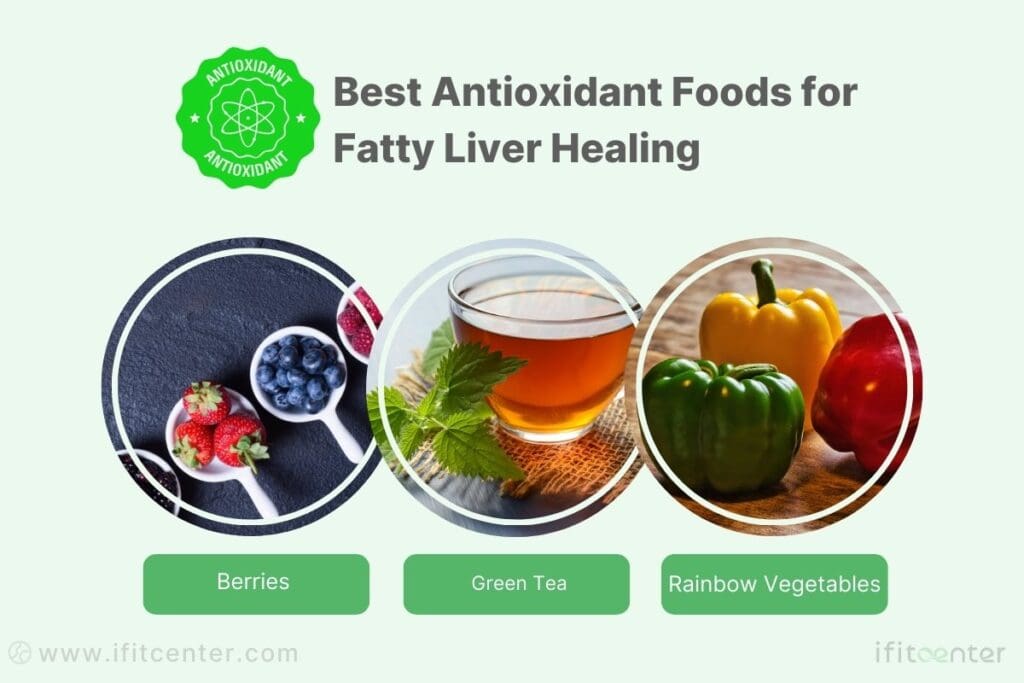
When it comes to fighting fatty liver disease, antioxidants act like your liver’s personal protection squad. Recent research shows that specific antioxidant-rich foods can reduce liver inflammation and help reverse fat accumulation.
“Here’s something fascinating I’ve observed in treating fatty liver disease: patients who combine antioxidant-rich foods with protein sources show significantly better liver enzyme improvements than those who focus on either nutrient alone. It’s not just about eating berries or fish – it’s about creating synergistic combinations that enhance the body’s natural healing processes.”
Dr. Babak Jamalian, Family Physician.
1. Power-Packed Berries for Liver Health
Berries contain unique compounds that actively support liver healing:
- Blueberries: Rich in anthocyanins that reduce liver inflammation
- Strawberries: Contain ellagic acid that helps prevent liver fat accumulation
- Raspberries: Provide powerful antioxidants that protect liver cells
2. Green Tea Benefits for Fatty Liver
Green tea’s catechins make it a powerful ally in liver health. Studies show that drinking 2-3 cups daily can:
- Reduce liver fat
- Lower harmful liver enzymes
- Protect against liver cell damage
Note: Green tea consumption should not exceed 3 cups per day.
3. Rainbow of Liver-Protecting Vegetables
Each color provides different antioxidants that support liver health:
- Red: Bell peppers, tomatoes (rich in lycopene)
- Orange: Carrots, sweet potatoes (beta-carotene)
- Purple: Eggplant, purple cabbage (anthocyanins)
Best Healthy Fats for Fatty Liver Recovery
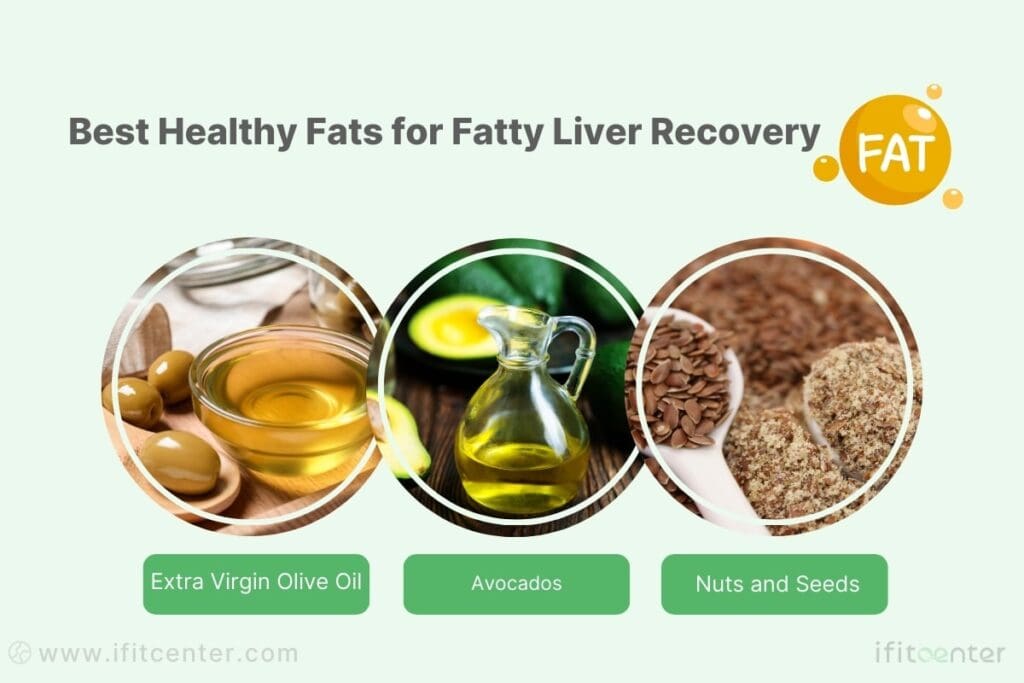
Contrary to what many believe, certain fats are essential for healing fatty liver disease. The key is choosing the right types and amounts.
1. Extra Virgin Olive Oil: Your Liver’s Best Friend
Research shows that 1-2 tablespoons of extra virgin olive oil daily can:
- Reduce liver fat accumulation
- Lower inflammation markers
- Improve liver enzyme levels
2. Avocados: Nature’s Perfect Liver Support
Avocados provide a unique combination of healthy fats and antioxidants that:
- Support natural liver cleansing
- Help reduce inflammation
- Protect liver cells from damage
3. Best Nuts and Seeds for Liver Health
- Walnuts: Rich in omega-3s and antioxidants
- Almonds: High in vitamin E for liver protection
- Flaxseeds: Provide lignans and omega-3s
Optimal Daily Intake Guide
For maximum liver benefits, aim for:
- 1-2 cups of berries daily
- 2-3 cups of green tea
- 4-5 servings of colorful vegetables
- 1-2 tablespoons of extra virgin olive oil
- 1/4 – 1/2 avocado daily
- 1 ounce of nuts or seeds
“The combination of antioxidants and healthy fats provides a powerful one-two punch against fatty liver disease, supporting both prevention and healing.”
Remember to introduce these foods gradually and listen to your body’s response. The goal is to create sustainable, long-term habits that support your liver health.
Medical Supervision for Fatty Liver Recovery: A Science-Based Approach
Improving fatty liver isn’t just about eating the right foods—it’s about structuring your nutrition and lifestyle in a way that actively supports liver regeneration. While incorporating essential foods is a great start, personalized medical guidance ensures that your approach is both effective and sustainable. At IFitCenter, under the expert care of Dr. Babak Jamalian, we design medically supervised weight management programs that specifically target fat reduction in the liver, helping patients achieve long-term metabolic health.
If you want to take a scientific and structured approach to reversing fatty liver, book a consultation today.
How to Include Liver-Healthy Foods in Your Daily Diet: A Practical Guide
Knowing which foods support liver health is one thing – incorporating them into your daily routine is another. Let’s turn knowledge into action with practical, easy-to-follow steps.
7-Day Liver-Healthy Meal Combinations
Here are seven proven meal combinations that maximize the benefits of liver-healthy foods:
- Breakfast Champion: Steel-cut oats + blueberries + walnuts + green tea
- Power Lunch: Quinoa + grilled salmon + sautéed leafy greens + olive oil dressing
- Energy Dinner: Lentils + roasted vegetables + avocado + herbs
- Quick Snack: Apple slices + almond butter + cinnamon
3 Quick and Easy Recipes for Fatty Liver
1. Liver-Supporting Breakfast Bowl
Preparation time: 10 minutes
- 1 cup cooked quinoa
- 1/2 cup mixed berries
- 1 tablespoon flaxseeds
- 1/4 avocado
- Green tea on the side
2. Antioxidant-Rich Lunch Salad
Preparation time: 15 minutes
- 2 cups mixed leafy greens
- 3 oz grilled salmon
- 1/4 cup chickpeas
- Olive oil + lemon dressing
- Fresh herbs
3. Liver-Cleansing Dinner Bowl
Preparation time: 20 minutes
- 1 cup steamed broccoli
- 1/2 cup cooked lentils
- 1/4 avocado
- Turmeric-olive oil dressing
Smart Shopping List for Liver Health
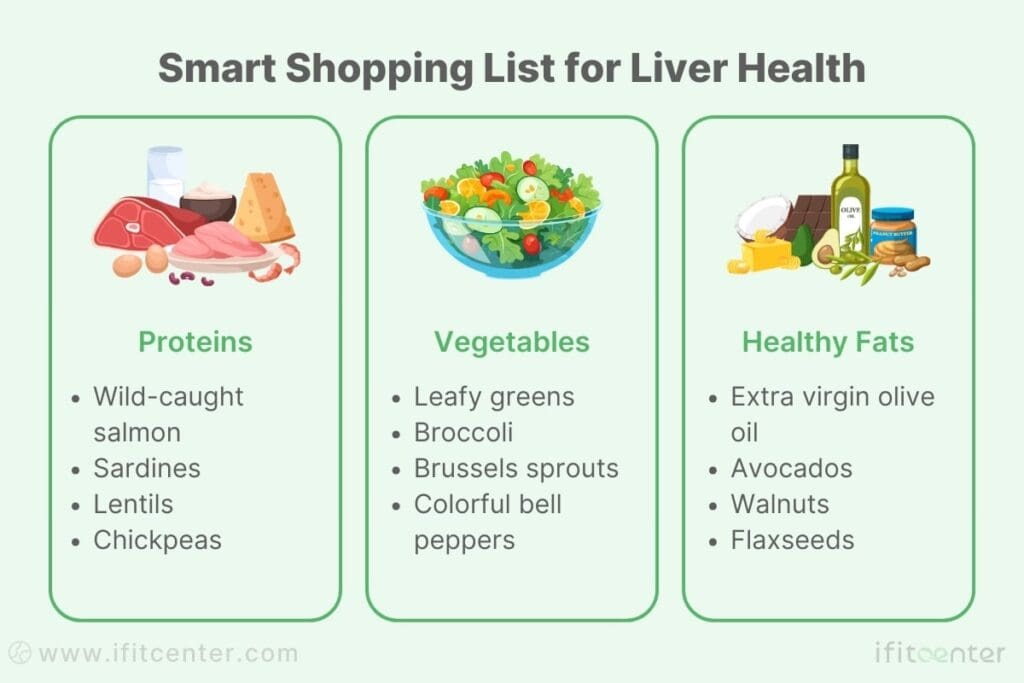
Print this list and keep it handy for your weekly shopping:
Food Storage Tips for Maximum Benefits
- Leafy Greens: Wash, dry thoroughly, wrap in paper towels and store in a sealed container
- Berries: Don’t wash until ready to eat, store in the original container with holes for airflow
- Nuts and Seeds: Store in airtight containers in the refrigerator to prevent rancidity
- Olive Oil: Keep in a dark, cool place away from direct sunlight
Remember, these changes don’t need to happen overnight. Start by incorporating one new recipe or food combination each week, and gradually build your liver-healthy eating habits.
Foods That May Worsen Fatty Liver: What to Know and What to Choose Instead
While knowing what to eat is crucial, understanding which foods might be hindering your liver’s recovery is equally important. Recent research shows that certain foods can increase liver fat by up to 30% in just a few weeks.
Key Foods That Impact Liver Health
1. Hidden Sugar Sources
Your liver processes every gram of sugar you consume. Research shows that excessive sugar intake can trigger a process called de novo lipogenesis, where your liver converts sugar directly into fat.
- Common Sources:
- Flavored yogurts (can contain up to 6 teaspoons of sugar)
- Breakfast cereals (even “healthy” options)
- Granola bars
- Fruit juices
- Better Choices:
- Plain yogurt with fresh berries
- Steel-cut oats with cinnamon
- Whole fruits instead of juices
- Homemade energy balls with dates and nuts
2. Refined Carbohydrates
Refined carbs are quickly converted to sugar in your body, leading to insulin spikes that can worsen fatty liver. Studies show they can increase liver fat accumulation by up to 27% over time.
- Common Sources:
- White bread and pastries
- White rice
- Processed snack foods
- Most packaged crackers
- Better Choices:
- Quinoa
- Brown rice
- Sweet potatoes
- Legumes
3. Inflammatory Oils
Not all fats are created equal. Certain oils can promote inflammation and increase liver stress.
- Common Sources:
- Corn oil
- Soybean oil
- Processed vegetable oils
- Most packaged snacks
- Better Choices:
- Extra virgin olive oil
- Avocado oil
- Cold-pressed coconut oil
- Natural fats from nuts and seeds
Smart Substitution Strategies
Making healthier choices doesn’t mean sacrificing taste. Here are practical swaps that support liver health:
- For Sweet Cravings:
- Replace soda with sparkling water infused with berries
- Swap ice cream for frozen blended berries with yogurt
- Choose dark chocolate (70%+ cacao) instead of milk chocolate
- For Salty Cravings:
- Replace chips with roasted chickpeas
- Swap pretzels for mixed nuts
- Choose vegetable sticks with hummus instead of crackers
“The key to sustainable liver health isn’t just about eliminating foods – it’s about making smarter choices that you can maintain long-term.”
Understanding your personal nutritional needs and creating a sustainable plan is crucial for liver health. Everyone’s body responds differently to dietary changes, which is why personalized guidance can make a significant difference in your success.
Your Next Steps: Starting Your Liver Health Journey
Throughout this guide, we’ve explored the science-backed foods that can transform your liver health. Let’s recap the key points and outline your path forward.
Key Foods for Liver Health: Quick Reference
- Protein Powerhouses:
- Wild-caught fatty fish
- Legumes and pulses
- Lean poultry
- Fiber Champions:
- Leafy greens
- Cruciferous vegetables
- Whole grains
- Antioxidant Stars:
- Berries
- Green tea
- Colorful vegetables
- Healthy Fats:
- Extra virgin olive oil
- Avocados
- Nuts and seeds
Your 3-Step Action Plan
Start your liver health journey with these simple steps:
- Week 1: Add Liver-Supporting Foods
- Include one serving of leafy greens daily
- Add berries to your breakfast
- Switch to extra virgin olive oil
- Week 2: Optimize Meal Timing
- Eat your largest meal before 3 PM
- Space meals 4-5 hours apart
- Include protein with each meal
- Week 3: Fine-Tune Your Choices
- Replace refined grains with whole alternatives
- Incorporate more variety in vegetables
- Experiment with new healthy recipes
What to Expect
Research shows that consistent implementation of these dietary changes can lead to:
- First Month: Improved energy levels and better digestion
- Three Months: Noticeable changes in liver enzyme levels
- Six Months: Significant reduction in liver fat content
“The journey to better liver health is a marathon, not a sprint. Each healthy choice you make is a step in the right direction.”
Everyone’s body responds differently to dietary changes. Understanding your personal starting point is crucial for tracking progress and adjusting your approach for optimal results.
Want to understand your current liver health status and get personalized recommendations? Take our free liver health assessment and receive a customized report with actionable insights for your journey.
Remember, the changes you make today can significantly impact your liver health tomorrow. Start small, be consistent, and celebrate each step toward better health.
To access other content on the IFitCenter’s blog, you can use the following links:
References “Foods Good for Fatty Liver”
This article is based on the following peer-reviewed studies and authoritative sources:
- Younossi, Z. M., et al. (2016). “Global epidemiology of nonalcoholic fatty liver disease—Meta‐analytic assessment of prevalence, incidence, and outcomes.” Hepatology, 64(1), 73-84. DOI: 10.1002/hep.28431
- Houttu V, Csader S, Nieuwdorp M, Holleboom AG, Schwab U. Dietary Interventions in Patients With Non-alcoholic Fatty Liver Disease: A Systematic Review and Meta-analysis. Frontiers in Nutrition. 2021;8:716783. DOI: 10.3389/fnut.2021.716783.
- Yaskolka Meir A, Rinott E, Tsaban G, et al. Effect of green-Mediterranean diet on intrahepatic fat: the DIRECT-PLUS randomised controlled trial. Gut. 2021;70(11):2085-2095. DOI: 10.1136/gutjnl-2020-323106.
- Romero-Gómez M, Zelber-Sagi S, Trenell M. The role of nutrition in non-alcoholic fatty liver disease: Pathophysiology and management. Liver International. 2020;40(S1):102-108. DOI: 10.1111/liv.14360.
- Perumpail BJ, Li AA, Iqbal U, et al. Potential Therapeutic Benefits of Herbs and Supplements in Patients with NAFLD. Diseases. 2018;6(3):80. DOI: 10.3390/diseases6030080.
- European Association for the Study of the Liver (EASL), European Association for the Study of Diabetes (EASD), European Association for the Study of Obesity (EASO). (2023). “EASL–EASD–EASO Clinical Practice Guidelines for the management of non-alcoholic fatty liver disease.” Journal of Hepatology, 72(2), 378-401.



